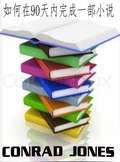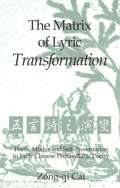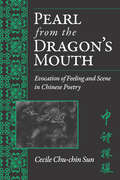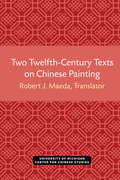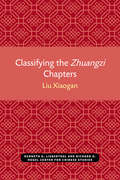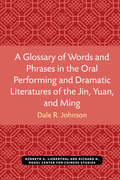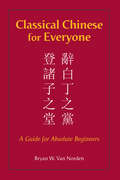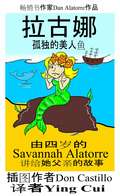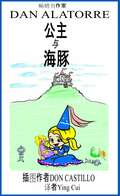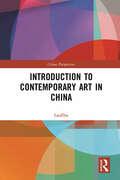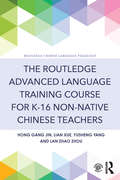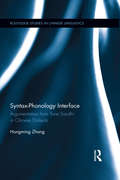- Table View
- List View
如何在90天内完成一部小说
by Conrad Jones Snow Zhong Mcdonald如何在90天内完成一部长篇小说—一个被成功的惊悚小说作者反复测试验证过的系统,这个作者从2008年起出版了12部小说! 康拉德是从商业投资的角度来开始写书的。这对于他来说,是职业上的转变,而不是一件附庸风雅的事。他虽然最终通过他的书得到了一份可敬的收入,但在事情的开始并不是那么简单,在这个过程中他也得到了很多艰难的教训。基于他在销售行业的不同经验以及推销他的电子书所得到的经验,康拉德对作者们解释了哪些是可行的而哪些是不可行的。刚开始的时候他没有代理,也没有出版商指导并且对他的努力表示支持,相反,他通过尝试和错误艰难地学习。
The Matrix of Lyric Transformation: Poetic Modes and Self-Presentation in Early Chinese Pentasyllabic Poetry (Michigan Monographs In Chinese Studies #75)
by Zong-qi Cai Zong-qu CaiPentasyllabic poetry has been a focus of critical study since the appearance of the earliest works of Chinese literary criticism in the Six Dynasties period. Throughout the subsequent dynasties, traditional Chinese critics continued to examine pentasyllabic poetry as a leading poetic type and to compile various comprehensive anthologies of it. The Matrix of Lyric Transformation enriches this tradition, using modern analytical methods to explore issues of self-expression and to trace the early formal, thematic, and generic developments of this poetic form. Beginning with a discussion of the Yüeh-fu and ku-shih genres of the Han period, Cai Zong-qi introdues the analytical framework of modes from Western literary criticism to show how the pentasyllabic poetry changed over time. He argues that changing practices of poetic composition effected a shift from a dramatic mode typical of folk compositions to a narrative mode and finally to lyric and symbolic modes developed in literati circles.
Pearl from the Dragon’s Mouth: Evocation of Scene and Feeling in Chinese Poetry (Michigan Monographs In Chinese Studies #67)
by Cecile C. SunThe interplay between the external world (ching) and the poet’s inner world (ch’ing) lies at the heart of Chinese poetry, and understanding the interaction of the two is crucial to understanding this work from within its own tradition. Closely coordinating her discussions of poetry and criticism so that practice and theory become mutually enriching and illuminating, Sun offers sensitive and original readings of poems and a wealth of insights into Chinese poetics.
Two Twelfth-Century Texts on Chinese Painting (Michigan Monographs In Chinese Studies #8)
by Robert J. MaedaTwo Twelfth-Century Texts on Chinese Painting presents two texts in translation that provide dual insight into the Painting Academy of Emperor Hui-tsung and the literati school of painting. The Shan-shui ch’un-ch’uan chi is a treatise for beginning landscape painters dated to the Hsüan-ho era. The treatise was written by Han Cho, a reputed member of the Academy, but the text was not specifically directed at Academicians. The treatise collects and orders previous writings on landscape painting; one of Han Cho’s main goals is to list all landscape definitions and their practical application in painting. Yet his view is more detached and analytical than a stereotypical Academy painter, revealing an approach reminiscent of Confucian scholarship and literati painting as well. The Hua-chi by Teng Ch’un is a history of painting that was written as a sequel to two earlier painting histories. In ten chapters, Teng Ch’un compiles facts and critical evaluations of painters from 1075 to 1167, as well as listings of selected masterpieces. Teng Ch’un provides more specific information about the Academy than Han Cho, discussing its organization and examination system, and noting that “form-likeness” and adherence to rules were leading standards for painting in the Academy. On the other hand, he thinks that painting should transmit “soul,” not just “form.” Thus, Teng Ch’un writes the history of both the establishment values of the Academy and the intellectual tendencies of the literati.
Classifying the Zhuangzi Chapters (Michigan Monographs In Chinese Studies #65)
by Xiaogan LiuThe relationships, both historical and philosophical, among the Zhuangzi’s Inner, Outer, and Miscellaneous chapters are the subject of ancient and enduring controversy. Liu marshals linguistic, intertextual, intratextual, and historical evidence to establish an objectively demonstrable chronology and determine the philosophical affiliations among the various chapters. This major advance in Zhuangzi scholarship furnishes indispensable data for all students of the great Daoist text. In a lengthy afterword, Liu compares his conclusions with those of A. C. Graham and addresses the relationship between the Zhuangzi and the Laozi.
A Glossary of Words and Phrases in the Oral Performing and Dramatic Literatures of the Jin, Yuan, and Ming (Michigan Monographs In Chinese Studies #89)
by Dale R. JohnsonFor many years, the oral performing and dramatic literatures of China from 1200 to 1600 CE were considered some of the most difficult texts in the Chinese corpus. They included ballad medleys, comic farces, Yuan music dramas, Ming music dramas, and the novel Shuihu zhuan. The Japanese scholars who first dedicated themselves to study these works in the mid-twentieth century were considered daring. As late as 1981, no comprehensive dictionary or glossary for this literature existed in any language, Asian or Western. A Glossary of Words and Phrases fills this gap for Western readers, allowing even a relative novice who has resonable command of Chinese to read, translate, and appreciate this great body of literature with an ease undreamed of even two decades ago. The Glossary is organized into approximately 8,000 entries based on the reading notes and glosses found in various dictionaries, thesauruses, glossaries, and editions of works from the period. Main entries are listed alphabetically in the pinyin romanization system. In addition to glosses, entries include symbolic annotations, guides to pronunciation, and text citations. The result is a broadly useful glossary serving the needs of students of this literature as well as scholars researching Jin and Yuan language and its usage.
Classical Chinese for Everyone: A Guide for Absolute Beginners
by Bryan W. Van NordenIn just thirteen brief, accessible chapters, this engaging little book takes "absolute beginners" from the most basic questions about the language (e.g., what does a classical Chinese character look like?) to reading and understanding selections from classical Chinese philosophical texts and Tang dynasty poetry. "An outstanding introduction to reading classical Chinese. Van Norden does a wonderful job of clearly explaining the basics of classical Chinese, and he carefully takes the reader through beautifully chosen examples from the textual tradition. An invaluable work." —Michael Puett, Harvard University
拉古娜——孤独的美人鱼
by Dan Alatorre Ying Cui拉古娜----孤独的美人鱼 是本令人愉快的,有许多可爱图片的图画书 它讲述了一个孤独的小美人鱼的故事 她必须想出一个创造性的方式来营救被困海盗 通过帮助别人 她结交了新朋友 非常适合家长读给学龄前儿童 或年龄稍大的孩子读给家长 包括给家长的有关儿童趣味阅读的建议 在Facebook粉丝页下载填色画的链接等等
公主与海豚
by Dan Alatorre Ying Cui公主与海豚 是一本可爱的,有趣的图画书 书中有许多为儿童创作的可爱图片 它讲述了一位美丽的小公主的故事 她有一个非常特别的毛绒玩具 但她把它丢在了城堡的某个地方 在她的父母 国王和王后 和宠物狗的帮助下 他们展开了搜索 孩子们在享受一个有趣的好故事的同时 会学到坚持不懈很重要 合作和机智也很重要 您家的小公主可能会学到收好玩具的习惯 也许还能学会一点有关责任感的知识 非常适合家长读给学龄前儿童 或年龄稍大的孩子读给家长
Introduction to Contemporary Art in China (China Perspectives)
by Lao ZhuThe book is a collection of fifteen introductory essays excerpted from the Annual of Contemporary Art in China, covering the years from 2005 to 2019, showcasing the development and changing landscapes of contemporary art in China. The Annual documents exhibitions, events, creative practices, and critical literature concerning contemporary art in China since 2005. Based on archival documentation and statistics data from these annuals, notable phenomena, events, and discourses from a given year, as well as key works and artists are reviewed in each introduction, with no ideological or market-driven undertone. The author unravels industrial and institutional factors, while also broaching important issues of abstract art, new media art and so on, and probing the historical and socio-cultural context as well. In this regard, the book offers a panorama of contemporary Chinese art and critically engages with the art scene in China, including Hongkong, Taiwan, and among the Chinese diaspora. The title will appeal to scholars, students and general readers interested in contemporary art history, art criticism, contemporary Chinese art, iconography, and contemporary art theory.
The Routledge Advanced Language Training Course for K-16 Non-native Chinese Teachers (Routledge Chinese Language Pedagogy)
by Hong Gang Jin Lian Xue Yusheng Yang Lan Zhao ZhouThe Routledge Advanced Language Training Course for K-16 Non-native Chinese Teachers is a content-based and thematically organized textbook designed for non-native in- and pre-service K-16 Chinese language teachers. Based on five years of field testing, the book offers an innovative approach to advanced language instruction, allowing users to further advance their language proficiency while continuing their professional development in teaching Chinese as a second or foreign language. The textbook: covers a range of up-to-date pedagogical and cultural themes provides a variety of engaging activities and exercises, allowing readers for K-16 to explore pedagogical and cultural issues in the target language with best classroom practices in mind familiarises users with authentic forms of modern communication in today’s China to better engage learners is accompanied by a Companion Website with audio recordings for each lesson as well as supplementary materials and teaching resources. The Routledge Advanced Language Training Course for K-16 Non-native Chinese Teachers is an essential resource for non-native Chinese teachers and for those on TCFL teacher training programs.
Syntax-Phonology Interface: Argumentation from Tone Sandhi in Chinese Dialects (Routledge Studies in Chinese Linguistics)
by Hongming ZhangThis book centers on theoretical issues of phonology-syntax interface based on tone sandhi in Chinese dialects. It uses patterns in tone sandhi to study how speech should be divided into domains of various sizes or levels. Tone sandhi refers to tonal changes that occur to a sequence of adjacent syllables or words. The size of this sequence (or the domain) is determined by various factors, in particular the syntactic structure of the words and the original tones of the words. Chinese dialects offer a rich body of data on tone sandhi, and hence great evidence for examining the phonology-syntax interface, and for examining the resulting levels of domains (the prosodic hierarchy). Syntax-Phonology Interface: Argumentation from Tone Sandhi in Chinese Dialects is an extremely valuable text for graduate students and scholars in the fields of linguistics and Chinese.
